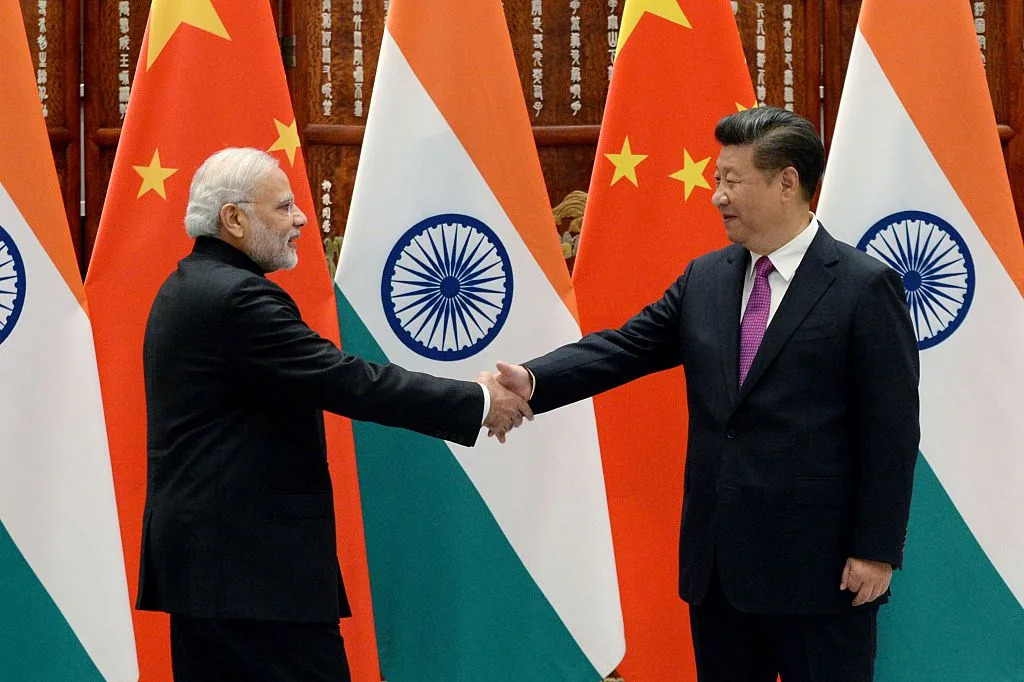
Indian Prime Minister Narendra Modi shakes hands with Chinese President Xi Jinping in Hangzhou, China, Sept. 4, 2016. Credit - Wang Zhou—Pool/Getty Images
India and China’s relationship is thawing as the U.S.’s ties with India chills under President Donald Trump.
Chinese Foreign Minister Wang Yi is reportedly on a visit to New Delhi this week on his first trip to India in more than three years, to meet with India’s National Security Adviser Ajit Doval and External Affairs Minister Subrahmanyam Jaishankar. On the agenda is the possibility of reducing the number of troops on the disputed Himalayan border, which would be a significant step in improving India-China relations since a deadly 2020 border clash that froze ties for years.
The regional neighbors’ warming ties is happening against the backdrop of Trump in recent months targeting India, a longtime friend of the U.S. that had been seen as a buffer against the influence of China in Asia. Trump imposed a “secondary tariff” on India as a penalty for its purchases of Russian oil, even as on Friday he ruled out doing the same for China, the biggest buyer of Russian oil, while Washington and Beijing engage in more trade talks.
Trump’s trade adviser Peter Navarro attacked India’s Russian oil purchases once more as “opportunistic and deeply corrosive” in a column published in the Financial Times on Monday. “This two-pronged policy will hit India where it hurts—its access to U.S. markets—even as it seeks to cut off the financial lifeline it has extended to Russia’s war effort,” Navarro wrote. “If India wants to be treated as a strategic partner of the U.S., it needs to start acting like one.”
The penalty has brought U.S. tariffs on India up to a staggering 50% rate. In the meantime, the Trump Administration has pressed India on agricultural concessions in order to reach a more favorable trade deal, which Indian Prime Minister Narendra Modi has refused to budge on.
“For the U.S., the strategic goal of keeping close ties with India is to balance China, prop up Washington’s weakened global position and, at least until recently, support the crumbling U.S.-led international order,” says Ivan Lidarev, a visiting research fellow at the National University of Singapore’s Institute of South Asian Studies who specializes in India-China relations.
But Trump’s volatile and at times punitive trade policies now appear to be pushing India towards China. Here’s what to know.
Trump tariffs damage U.S.-India trust
Trump’s strategy towards both U.S. adversaries like China and Russia as well as friends like India is “highly personalized, driven by domestic politics, inconsistent, and short-termist,” Lidarev says.
“Nevertheless, there is a certain strategic logic,” he adds. “The administration likely seeks to strengthen the U.S. position vis-à-vis China and secure strategic and economic gains through its Russia and India policies.”
The Trump Administration’s approach to India comes from a “trade perspective,” Vivek Mishra, deputy director of the Strategic Studies Programme at the Observer Research Foundation, tells TIME. At the center of Trump’s contentions with India, Mishra says, is “the idea that India should open its agriculture and dairy sectors,” which are politically sensitive markets.
But Trump’s attempts to pressure India have instead “undermined mutual trust” between the U.S. and India, and shaken Trump’s friendship with Modi, says Lidarev.
“This is not the way negotiations happen … Suddenly you have a team from the Trump Administration who have little experience in negotiations trying to enforce a certain decision,” Mishra adds. “This is almost like a breach of strategic trust that the U.S. and India have had for a long time.”
Moreover, the U.S. has also warmed relations with Pakistan after Trump claimed credit for brokering a cease-fire between New Delhi and Islamabad earlier this year. The move “has been met with shock and indignation in India” which views Pakistan with hostility, says Lidarev, while Pakistan has long been supported by China.
It also suggests that the U.S.-India relationship was already laden with “contradictions and false expectations,” he adds, noting: “It was unrealistic for Washington to expect that Delhi will align with it against Beijing, open fully its market to American companies and break off relations with Russia. Similarly, it was unrealistic for India to expect that U.S.’s strategic generosity toward it will continue indefinitely or that Washington will forsake developing relations with Islamabad to please Delhi.”
“The damage to the relationship will be serious but not fatal because the two sides need each other too much and have invested too heavily in their relationship to let it crumble,” says Lidarev. “Simply put, the cost of a U.S.-India break up is too high for both sides. The recent tensions are likely to result in a more restrained but still solid and important relationship, with lower levels of trust and greater limits on how far the relationship will develop.”
India-China ties warm as countries seek to diversify trade
Lidarev tells TIME that India and China’s relationship had already been improving over the last few years, especially as the two countries agreed to disengage militarily at their disputed border late last year.
India and China are aware of the “very high political, economic and military cost of frozen relations,” he says. “China felt it had pushed India too close to the U.S. while India realized that it was losing its vaunted strategic autonomy by getting too close to Washington and turning Beijing into an adversary.”
India and China are planning to resume direct passenger flights next month after a five year pause. And last month, Jaishankar, the external affairs minister, visited Beijing in his first trip to China since 2020. Modi is also expected to visit China at the end of August in his first trip there in seven years.
The seemingly accelerated detente has been catalyzed by Trump’s tariffs, which have made India and China, as well as the rest of the world, realize that they should diversify their trade. “Both sides realized the importance of their economic relationship and the huge potential of their bilateral trade and investment in an increasingly protectionist world,” Lidarev says.
The 50% U.S. tariff on India will cripple many of its sectors, while Trump has also threatened even higher sectoral tariffs, such as on pharmaceuticals. Meanwhile, while China and the U.S. extended their deadline to reach a trade deal and are continuing negotiations, Beijing has courted countries across Asia, Africa, South America, and even the E.U. to develop trade ties.
The Trump Administration “likely aims to force India to align strategically and economically with the U.S. and extract economic benefits by forcefully opening the Indian market” through its “secondary tariff” on India and its threats towards nations aligned with intergovernmental organization BRICS, Lidarev says. In so doing, the Administration hopes to use these gains as leverage in its negotiations with Beijing.
India, however, has defended its Russian oil purchases, although some of the country’s refiners have reportedly begun looking for alternatives. Modi’s upcoming meeting with Chinese President Xi Jinping, as well as meetings between Indian and Russian officials, also suggest that India is reluctant to buckle under U.S. pressure.
Improved India-China ties could destabilize U.S. influence
“Much depends on how long and deep the improvement of China-India relations will be,” says Lidarev, noting that relations have several times improved temporarily before straining again soon afterwards, especially over border disputes.
In the short-term, improved Sino-Indian relations could lead to friction with the Trump Administration, says Lidarev, especially at a time when Trump is trying to rebalance global trade dynamics, including between the U.S. and China, in the U.S.’s favor. But, he adds, in the long-term, it could strengthen U.S. resolve to keep India as a friend, lest it lose its buffer in Asia.
“While it will augment U.S. mistrust of India, it is likely to increase India’s value as a partner and push Washington to shore up its relations with Delhi as a result of the inherent logic of the competition between China and the U.S.,” says Lidarev. “Much of the rapprochement between the U.S. and India in the last two decades is the product of India’s position as the key ‘swing nation’ in this competition and Washington’s increasingly successful attempts to woo it to its side.”
Ultimately, though, the perception of the U.S. as an unreliable partner will “increase the international trend toward greater multipolarity,” Lidarev tells TIME.
“Not only will India’s role as an independent pole less tied to the U.S. grow, but its closer relations with China, Russia, and the E.U. will strengthen these actors’ positions as other major poles in the international system,” he says. Furthermore, the dynamic could legitimize emerging international institutions like BRICS “as a hedge against dependence on Washington.”
India’s seemingly firm response to Trump’s threats may also have signaled to China that India has not walled itself off from developing ties with U.S. adversaries, says Lidarev.
“The logic behind U.S. actions is based on the dubious proposition that the U.S. enjoys the same power position in the international system as it did in the 1990s and has decisive leverage over other powers such as India and Russia,” he says. “In this sense, U.S. policy toward India, Russia, and China is an important test for Trump’s vision of international relations and U.S. role in them. At present, the Trump administration is increasingly discovering the limits of American power.”
Contact us at [email protected].







Comments